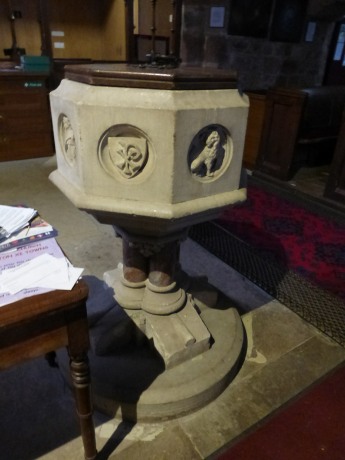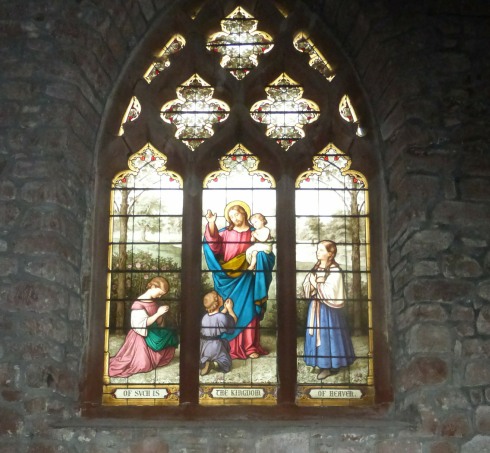
 |
In
1868 a huge programme of restoring and improving St. John the Baptist Church in
Ruyton XI Towns was instigated by the Vicar, Rev. Frederick Paget Wilkinson. The re-opening of the Church after all the
work was completed, was indeed a grand affair.
The
detailed description of events recorded in the Shrewsbury Chronicle in
September 1868 was researched by Irena White.
However, things were reported in the very fullest details in the 19th
century so I have taken the liberty of editing the text to tell the essentials
of the work. The full text can be
obtained by contacting Irena – Bersedrelincourt@aol.com
The Church is dedicated to St John the Baptist.
It is of Norman foundation, the chancel of that date remaining almost entire. The
building originally consisted of a nave and chancel only; subsequentaly a
narrow aisle was added to the north, the arcade of which is one of the most
singularly made specimens of construction extant. In the sixteenth century, a
very fine tower was added to the west and within the last half century the
narrow north aisle gave place to a very capacious addition, nearly equal in
area to the nave of the church. Later still the present Vicar has restored,
re-roofed, and refitted the chancel, and has now effected the same improvements
to the rest of the church, lowering the floor to one of the old pavements (one
still older having been found some inches below) re-paving, reseating with oak,
warming with hot water, and generally improving the structure. It must also be
mentioned that the fine peal of six bells which have been fixed in the tower
were procured through the efforts of the Vicar. Further efforts are required to
re-cast the very ugly porch and to clear away the earth from the walls of the building.
The whole of the work has been carried out in a most satisfactory manner under
the superintendence of Mr. Pountney-Smith, architect, Shrewsbury.
A new window, which has been inserted in the
south wall in the Baptistry bay of the church, contains a very good specimen of
storied stained glass. It is the gift of a kind benefactor, and as supplied by
the local artists, Messrs.Done and Davies, of Shrewsbury. The subject on the
left hand opening represents “The Baptism“.
Between the bottom of the subject and the small base of rich Mosaic
stained glass at the bottom of the window, is an inscription relating to the subject,--“Thus
it becometh us to fulfill all righteousness”. In the right hand opening is a
design taken from the left “Suffer little children to come unto me “.
On the right hand of our Savior is the mother
with two other of her children. Above each of the subjects is a canopy. In the
quatrefoil above the heads are introduced the lily and the passion flower. The
colouring of the whole is very beautiful and the drawing bold; and in all
respects really excellent. The same firm has also filled the large west window
with grisailled glass, with richly stained border all round. In the tracery of
the window are the figures of our Savior, and the patron saint of the Church,
St John the Baptist. The window is of excellent design and very effective,
while the price is so low as to render it especially suitable when cheapness is
an object.
The cost of the restoration is from £800 to £1000,
The nave has been restored, and a great portion of the interior re-seated with
open pews of strong oak. The Gallery has also been removed.
There is
also a new and elegantly-designed Font, by Percival, the carvings on which have
been most chastely and elaborately executed. The base or platform is of York
stone with coloured marble pedestal, surmounted by the Font in Bath stone, and
on which is carved the monogram “I.H.S.” and four symbolic representations of
the Four Evangelists. This beautiful Font is the gift of Mr. Walford.
There is a beautiful chancel organ built by
Bevington, London which has been erected by Mr. Norris, of the same firm, who presided
very efficiently. It is of the over-hanging style and possesses six stops—open
diapason stop diapason, treble and bass, principal dulciana, bourdon and
prepared for mixture speaking front, decorated pipes and has an octave and a
half of pedals , Immediately in front is the very appropriate inscription “ Let
everything that has breath praise the Lord “.
The Church also contains several beautiful
stained and painted glass windows one very fine one being “Christ blessing
little children “underneath which is the inscription “Of such is the Kingdom of
Heaven “. The Hunt Window.
The church has been most tastefully decorated
with flowers, evergreens, ears of corn and other emblems of harvest time. At
the entrance were two illustrated texts in red letters, white ground and green
borders “Peace be within thy walls .and prosperity within thy palaces” and The
Lord is in His holy temple “The chandeliers in the aisle were also draped with flowers.
The decorations reached their climax at the altar
underneath the beautiful East window, the subject of which latter is “The Crucifixion”.
Underneath the painting, in the window-sill, was a sheaf of corn and a little
below that was a richly executed “Cross” on a white ground, with a scarlet
border, enriched with some green tracery.
Halfway up the cloth on the communion table was another beautifully
worked “Cross”. The windows all around the church were also decorated with
flowers and evergreens. About half-past eleven the clergy entered the church in
procession, wearing their surplices and hoods and chanting the processional
hymn “We love the place O’God “The service was a full choral one, Tallis being
used throughout. (Thomas Tallis was a 16th
Century composer of choral music.) After
the service the Recessional Hymn “Oft is the danger, oft is the woe” was
chanted by the clergy on leaving the Church. The voluntary played as the
congregation was leaving was the “Offertorie”. The sermon was preached by the
Rev. Charles Orlando Kenyon, Rural Dean, “ For where two or three are gathered
together in my name, there am I in the midst of them “ He said the object of
their assembling together that day was twofold , the first being to thank
God who had enabled them to restore
their Church and the second was to thank God for giving them so bountiful a
Harvest in the somewhat exceptional season which they had passed for lack of
rain . After the sermon a collection was made for the restoration Fund.
The Luncheon.
Took place in a tent which had been tastefully
decorated for the occasion with mottoes, flags, banners and floral decorations.
At 2 O’clock almost two hundred ladies and gentlemen sat down to an excellent
luncheon provided by Mr. and Mrs. Benbow of the Admiral Benbow Inn , and under
the Presidency of J.R.Kenyon,Esq,Q.C.,supported on his right and left by the
Rev.F.P.Wilkinson,Vicar of Ruyton; Rev.W.Jones.Baschurch; D.F.Atcherley.Eq.Marton Hall; Colonel Kenyon
Slayney; Rev N.Cooper. J.Humphreys.Esq.Hanley Hall; Rev C.O.Kenyon. Rev.E.W.O.Bridgeman.
Rev.P.G.Bentley & co.
After Luncheon there followed a series of
toasts with rejoinders of thanks -
The Chairman rose to give the first toast of
the evening “Church and Queen“
Mr Minton proposed the Bishop and Clergy of the Diocese.
The Rev C.O.Kenyon returned thanks.
D.F.Atcherley,Esq.;proposed the
Army,Navy,Yeomanry Militia and Volunteers ,coupling with the toast the names of
Colonel Kenyon Slaney, Major Rowland Kenyon, Sergeant Major Morris, Captain
Fenwick and Lieut Percival ( Applause ).
Colonel Kenyon return thanks on behalf of the Army.
After detailing the recent achievements in Abyssinia.
Major Rowland Kenyon on behalf of the Militia;
Captain Fenwick for the Navy; and Lieutenant Percival for the Volunteers, then
briefly returned thanks (Applause).
The Chairman then proposed the health of their
respected Vicar, the Rev. F.P.Wilkinson. The toast was drunk with three cheers
and one more for Mrs. Wilkinson and her family).
The Rev.F.P.Wilkinson returned thanks on behalf
of himself and Mrs. Wilkinson and family.
He referred to the great kindness of the late Rectors wife (Mrs. Evans)
who left a sum of money for the organ; and to return his thanks to Mr. Minton
for his exertions on behalf of the three additional bells; to Mr. Pountney
Smith their Architect; to Messrs Evans and Morris for the heating apparatus in
the church; to Mr. Kenyon for his invaluable assistance; to Mr. John Basnett, Mr.Oswell,
Mr. Stokes and others; To Mr. Norris of
London who had presided at the organ that day & proposed the health of the Churchwardens
and the Committee of Management.
Mr. Basnett briefly returned thanks.
Colonel Kenyon Slaney proposed “Success to
Agriculture “and coupled it with it the name of John Humphreys Esq. of Hanley Hall.
T Humphreys Esq. returned thanks and proposed
the health of Rev. W.Jones of Baschurch , who returned thanks .
The Rev.F.P.Wilkinson proposed the health of
the Chairman J.E.Kenyon Esq. and the Hon Mrs. Kenyon of The Pradoe and Family. The Chairman feelingly and appropriately, responded.
The Rev W.Gibson Proposed , The Ladies. Mr. Shaw responds.
D.F.Atcherly Esq. Proposed,The Press. Mr. Leery responds
YB
 |
|
 |
| The Font by Percival, donated by Mr. Walford of Ruyton Towers |
The Hunt Window, in
memory of 4 children from Park House.
"Suffer little Children " |